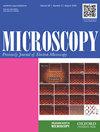TEM and STEM-EDS evaluation of metal nanoparticle encapsulation in GroEL/GroES complexes according to the reaction mechanism of chaperonin
IF 1.8
4区 工程技术
引用次数: 1
Abstract
Escherichia coli chaperonin GroEL, which is a large cylindrical protein complex comprising two heptameric rings with cavities of 4.5 nm each in the center, assists in intracellular protein folding with the aid of GroES and adenosine triphosphate (ATP). Here, we investigated the possibility that GroEL can also encapsulate metal nanoparticles (NPs) up to ∼5 nm in diameter into the cavities with the aid of GroES and ATP. The slow ATP-hydrolyzing GroEL D52A/D398A mutant, which forms extremely stable complexes with GroES (half-time of ∼6 days), made it possible to analyze GroEL/GroES complexes containing metal NPs. Scanning transmission electron microscopy–energy-dispersive X-ray spectroscopy analysis proved distinctly that FePt NPs and Au NPs were encapsulated in the GroEL/GroES complexes. Dynamic light scattering measurements showed that the NPs in the GroEL/GroES complex were able to maintain their dispersibility in solution. We previously described that the incubation of GroEL and GroES in the presence of ATP·BeFx and adenosine diphosphate·BeFx resulted in the formation of symmetric football-shaped and asymmetric bullet-shaped complexes, respectively. Based on this knowledge, we successfully constructed the football-shaped complex in which two compartments were occupied by Pt or Au NPs (first compartment) and FePt NPs (second compartment). This study showed that metal NPs were sequentially encapsulated according to the GroEL reaction in a step-by-step manner. In light of these results, chaperonin can be used as a tool for handling nanomaterials.根据伴侣蛋白的反应机理对GroEL/GroES复合物中金属纳米粒子包封的TEM和STEM-EDS评估
大肠杆菌伴侣蛋白GroEL是一种大的圆柱形蛋白质复合物,包括两个中心各有4.5nm空腔的七聚环,在GroES和三磷酸腺苷(ATP)的帮助下帮助细胞内蛋白质折叠。在这里,我们研究了GroEL也可以在GroES和ATP的帮助下将直径高达~5 nm的金属纳米颗粒(NP)封装到空腔中的可能性。缓慢ATP水解的GroELD52A/D398A突变体与GroES形成极其稳定的复合物(半衰期约6天),使分析含有金属NP的GroEL/GroES复合物成为可能。扫描透射电子显微镜-能量色散X射线光谱分析清楚地证明,FePt NPs和Au NPs被包裹在GroEL/GroES复合物中。动态光散射测量表明,GroEL/GroES复合物中的NP能够保持其在溶液中的分散性。我们之前描述过,GroEL和GroES在ATP·BeFx和二磷酸腺苷·BeFx存在下的孵育分别导致对称足球形和不对称子弹形复合物的形成。基于这些知识,我们成功地构建了足球形状的复合体,其中两个隔间被Pt或Au NP(第一隔间)和FePt NP(第二隔间)占据。该研究表明,金属NP是根据GroEL反应以逐步的方式顺序封装的。鉴于这些结果,伴侣蛋白可以用作处理纳米材料的工具。
本文章由计算机程序翻译,如有差异,请以英文原文为准。
求助全文
约1分钟内获得全文
求助全文
来源期刊

Microscopy
工程技术-显微镜技术
自引率
11.10%
发文量
0
审稿时长
>12 weeks
期刊介绍:
Microscopy, previously Journal of Electron Microscopy, promotes research combined with any type of microscopy techniques, applied in life and material sciences. Microscopy is the official journal of the Japanese Society of Microscopy.
 求助内容:
求助内容: 应助结果提醒方式:
应助结果提醒方式:


